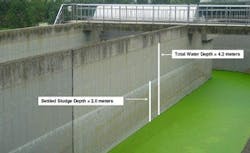Deep Ditch Minimizes Footprint
| Related Searches from WaterInfoLink.com Aerators | Aeration Industries | Lin An, China | Oxidation Ditch |
A goal of many communities in planning wastewater treatment facilities is to minimize the footprint, reducing land use. To reach this goal, a Chinese municipality built its oxidation ditch to deeper parameter depths than conventional designs but experienced serious process and mechanical issues.
Officials found that not all aerators are equal. For tackling this deep ditch activated sludge system, the right system was the Aire-O2 Triton aerator/mixer .
The city of Lin An, China, is located about 31 miles west of Hangzhou, the capitol of Zhejiang Province. The city’s wastewater treatment facility is an oxidation ditch system with an influent flow of 10.5 million gal per day (mgd), with influent BOD at 200 mg/L, total suspended solids (TSS) at 200 mg/L and phosphorus at less than 3 mg/L.
The Lin An oxidation ditch has a total water depth of 13.7 ft, nearly twice the depth found in conventional brush rotor type ditches that are approximately 6 to 8 ft deep.
The Importance of Mixing
The facility’s original system design was equipped with 50-hp brush rotor type aerators in the two ring ditches. The facility had been experiencing treatment process problems with the system, including difficulties in maintaining mixing velocities in the ditch to keep solids in suspension for biological treatment. Meeting permit regulations became more challenging.
Maintenance of the rotors was a big problem and compounded the mixing inadequacies. The gears on the brush rotor type aerators had to be continually replaced. These aerators required expensive maintenance, downtime and many manpower hours. The brush rotor system type also releases aerosols into the air with the exchange of air and wastewater. As the treatment process deteriorated, the noxious odor also became a nagging problem for the community.
Process Performance
The Lin An officials decided to upgrade and expand the plant to a three-ring design. The aeration system of choice was the Aire-O2 process aerator/mixer system . The total number of units installed was 16 x 30 hp and 16 x 20 hp units.
The system creates a high-velocity, horizontal mixing flow pattern for maximum treatment efficiency. The units are capable of mixing to 33 ft deep, oxygenating with fine bubble oxygen dispersion that keeps solids in suspension. This optimizes the treatment process and eliminates dead zones and sludge buildup.
Using smaller aerator/mixers allows for “turn-down capability,” whereby one or more units (aeration and mixing) can be turned entirely on or off to match BOD demand and flow fluctuations, which improves process operation and minimizes operating costs, such as electrical consumption. This also allows for nitrification (aeration and mixing) or denitrification (in the mixing only mode), a feature unavailable in the brush rotor system.
The Lin An wastewater treatment facility is now a showcase site, meeting its permit discharge limits. Effluent discharge BOD is less than 20 mg/L, TSS is less than 20 mg/L and phosphorus is less than 0.5 mg/L.
